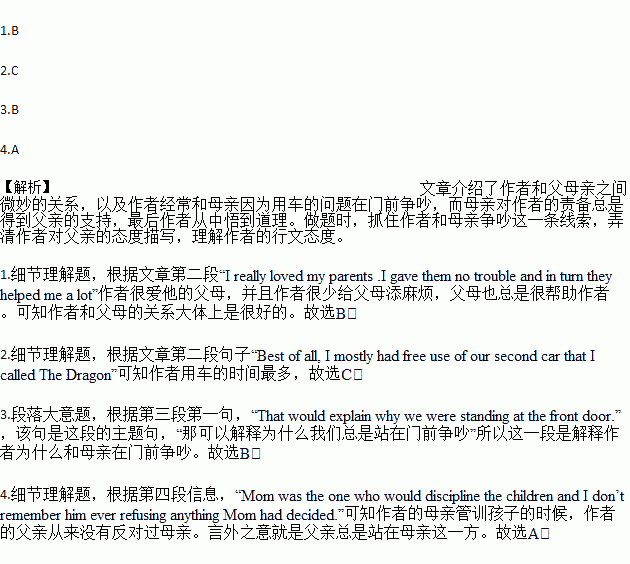题目内容
To this day, I don’t remember what the argument was about .I just remembered that it was a good one.
I really loved my parents .I gave them no trouble and in turn they helped me a lot. Best of all, I mostly had free use of our second car that I called The Dragon. But sometimes she needed it. And that’s what Mom and I were arguing about as we stood there at the front door of the condo(公寓租房) It was really the only thing she and I ever argued about .
That would explain why we were standing at the front door. I almost never used it because the back door was closer to where the cars were parked. So if I was it the front door, that meant I was coming in front having walked. But I’m not much of a walker .
Whatever we were arguing about, the words got heated enough to attract Dad’s attention, and he wandered over to the front door and stood behind Mom .That was sort of how it worked in our family .Mom was the one who would discipline the children and I don’t remember him ever refusing anything Mom had decided.
So mom and I was arguing and during argument I called my Mom a …No sooner had that word escaped, my lips but I felt the strong hand of my father against my cheek . It was the only time I can remember my father striking me. We all stood there ,staring at each other . Finally I looked my Dad directly in the eye.” I deserved that ,”I said.
I really believed that. Mom had kept telling me before : “You can choose your actions, but you can’t choose the results of your actions.” We make choices, which affect others, and they react. Recognizing that our choices have consequences is a good lesson that life teaches us.
1.Generally speaking, the author and his parents_____.
A. often had words with each other
B. got along well with each other
C. didn’t respect his mother at all
D. fought each other over the car
2.Who used The Dragon most of the time?
A. The author’s father.
B. The author’s mother
C. The author himself.
D. The author’s brothers.
3.The main purpose of Paragraph 3 is to mean that _______
A. the author hated outdoor activities
B. why the author stood at the front door
C. the author never used his walking machine
D. why the author was not much of a walker
4.What did his father often do when the author’s mother disciplined him?
A. He supported the author’s mother
B. He didn’t care about their argument
C. He worked as a fair judge
D. He had to protect the author
At the beginning of the twentieth century,many people thought that the American family was falling apart.A century later,we know that this was not the case.However,although the family is still alive in the United States,its size and shape were very different 100 years ago.
In the late 1800s and early 1900s,there were mainly two types of families in the United States: the extended and the nuclear.The extended family usually includes grandparents,parents,and children living under the same roof.The nuclear family consists of only parents and children.
Today there are many different kinds of families.Some people live in “traditional” families,that is,a stay?home mother,a working father,and their own biological children.Others live in two?paycheck families,single?parent families,adoptive or foster families,blended families (where men and women who were married before marry again and combine the children from previous marriages into the new families),childless families,and so on.
What caused the structure of the family to change? In the early 1900s the birthrate began to fall and the divorce rate began to rise.Women were suddenly choosing to go to college and take jobs outside the home.In the 1930s and 1940s,many families faced serious financial,or money problems during the Great Depression,when many people lost their jobs.During World War Ⅱ(1939-1945),5 million women were left alone to take care of their homes and their children.Because many men were at war,thousands of these “war windows” had to go to work outside their home.
During the next ten years,the situation changed.There were fewer divorces,and people married at a younger age and had more children than the previous generation.It was unusual for a mother to work outside the home during the years when her children were growing up.Families began leaving cities and moving into single?family homes in the suburbs.The traditional family seemed to be returning.
In the years between 1960s and 1990s,there were many important changes in the structure of the family.From the 1960s to the early 1970s,the divorce rate doubled and the birthrate fell by half.The number of single?parent families tripled,and the number of couples living together without being married doubled again.In fact,the single?parent household,once unusual,has replaced the “traditional” family as the typical family in the States.If we can judge from history,however,this will probably change again in the twenty?first century.
The Changes of the American Family
Main comparisons | Contexts | |
Different 1. | There were two 2.types of families in the past, 3.,the extended and the nuclear. | |
Nowadays 4.types of families can be seen than before. | ||
Changes in different 5. | In the 1900s and 1940s | Many of the women had to work outside due to the 6.of money,thus causing the fall of 7. and the rise of divorce rate. |
In the 1950s | Divorce rate slide and there were more children.The families tended to be 8.again. | |
In the years between 1960s and 1990s | Different types of families 9..Traditional families are no longer the typical ones in America. | |
A trend worth noting Author's opinion on changes | Judging from what has happened in the past,it is 10.that the present structure will experience changes again in the near future. | |

